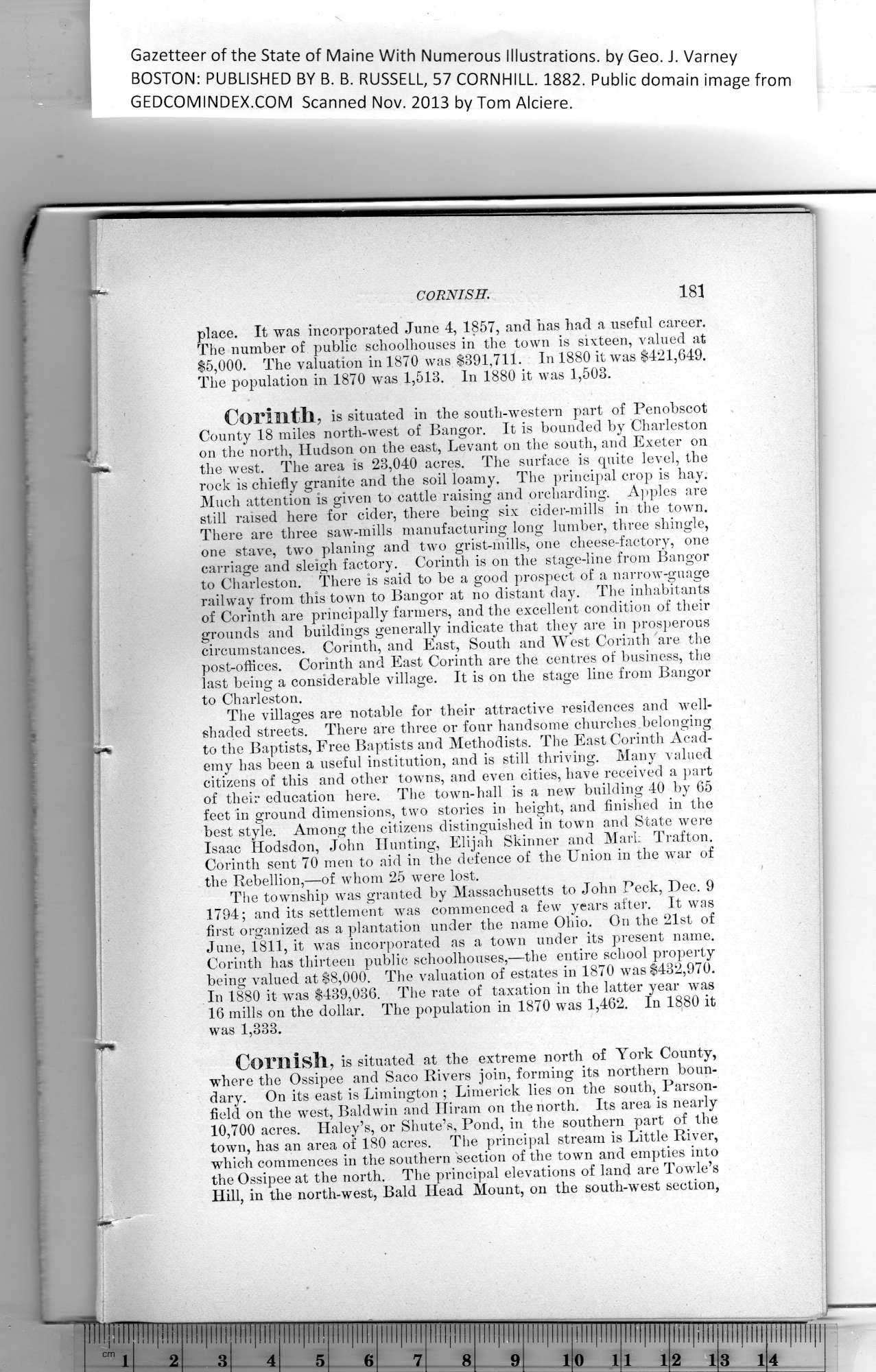|
CORNISH. 181
Gazetteer of the State of Maine With Numerous Illustrations, by Geo. J. Varney
Jam
place. It was incorporated June 4, 1857, and has had a useful career.
The number of public schoolhouses in the town is sixteen, valued at
$5,000. The valuation in 1870 was $391,711. In 1880 it was $421,649.
The population in 1870 was 1,513. In 1880 it was 1,503.
Corinth, is situated in the south-western part of Penobscot
County 18 miles north-west of Bangor. It is bounded by Charleston
on the north, Hudson on the east, Levant on the south, and Exeter on
the west. The area is 23,040 acres. The surface is quite level, the
rock is chiefly granite and the soil loamy. The principal crop is hay.
Much attention is given to cattle raising and orcharding. Apples are
still raised here for cider, there being six cider-mills in the town.
There are three saw-mills manufacturing long lumber, three shingle,
one stave, two planing and two grist-mills, one cheese-factory, one
carriage and sleigh factory. Corinth is on the stage-line from Bangor
to Charleston. There is said to be a good prospect of a narrow-guage
railway from this town to Bangor at no distant day. The inhabitants
of Corinth are principally farmers, and the excellent condition of their
grounds and buildings generally indicate that they are in prosperous
circumstances. Corinth, and East, South and West Corinth are the
post-offices. Corinth and East Corinth are the centres of business, the
last being a considerable village. It is on the stage line from Bangor
to Charleston.
The villages are notable for their attractive residences and well-
shaded streets. There are three or four handsome churches belonging
to the Baptists, Free Baptists and Methodists. The East Corinth Acad-
emy has been a useful institution, and is still thriving. Many valued
citizens of this and other towns, and even cities, have received a part
of their education here. The town-hall is a new building 40 by 65
feet in ground dimensions, two stories in height, and finished in the
best style. Among the citizens distinguished in town and State were
Isaac Hodsdon, John Hunting, Elijah Skinner and Marl; Trafton.
Corinth sent 70 men to aid in the defence of the Union in the war of
the Rebellion,—of whom 25 were lost.
The township was granted by Massachusetts to John Peck, Dec. 9
1794; and its settlement was commenced a few years after. It was
first organized as a plantation under the name Ohio. On the 21st of
June, 1811, it was incorporated as a town under its present name.
Corinth has thirteen public schoolhouses,—the entire school property
being valued at $8,000. The valuation of estates in 1870 was $432,970.
In 1880 it was $439,036. The rate of taxation in the latter year was
16 mills on the dollar. The population in 1870 was 1,462. In 1880 it
was 1,333.
Comish, is situated at the extreme north of York County,
where the Ossipee and Saco Rivers join, forming its northern boun-
dary. On its east is Limington ; Limerick lies on the south, Parson-
field on the west, Baldwin and Hiram on the north. Its area is nearly
10,700 acres. Haley’s, or Shute’s, Pond, in the southern part of the
town, has an area of 180 acres. The principal stream is Little River,
which commences in the southern section of the town and empties into
the Ossipee at the north. The principal elevations of land are Towle’s
Hill, in the north-west, Bald Head Mount, on the south-west section,
PREVIOUS PAGE ... NEXT PAGE
This page was written in HTML using a program written in Python 3.2
|
